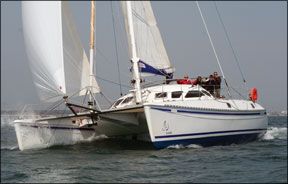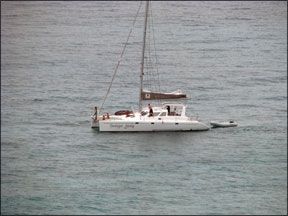After starting out in monohulls many years ago, Im now cruising aboard my third catamaran. All of my cats-a Maine Cat 30, a Kelsall 40, and now an Outremer 45-could be classified as performance cruisers: light weight, narrow hulls, daggerboards, and generous sailplans. I try to stay out of the mono/multi debate-were all sailors, and all boats have their pros and cons.

Photos courtesy of Outremer
One of the first questions that comes up regarding cruising cat design is whether daggerboards or fixed keels are better. My Maine Cat had one daggerboard, and my Outremer has two. My Kelsall came with keels, which I eventually cut off and replaced with daggerboards. I like boards, but the pros and cons are worth considering.
Daggerboard boats cost a bit more to build and buy, and have a few extra rigging bits to maintain and to handle when sailing. Mini keels are simple and sturdy. Interestingly, in the U.S., daggerboards are the exception; in the multihull hotbed of East Australia, keels are the exception. Sailing conditions are similar, so go figure.
Contrary to popular opinion, well-designed keel cats can sail to weather fairly well. The windward advantage of a good daggerboards is, at most, about 5 to 7 degrees (on each tack). That can be significant, but weatherliness alone is not why I prefer daggerboards.
The under-rated sailing advantage of boards is raising them off the wind; the reduction in wetted surface is considerable, and the extra leeway allows a deeper course while keeping the sails drawing and building apparent wind. Other advantages are the stability of sailing downwind in big seas with the only lateral planes at the sterns; and the ability to use the boards to balance the sailplan, easing the workload on the autopilot. Lastly, one board fully extended makes a great pivot point for close-quarters maneuvering.
Daggerboard boats usually draw less, at the expense of less protection for rudders and props. Our Outremer is advertised as having a draft of 2 feet with the boards up, but the reality is that the rudders and saildrives are protected by an armored skeg that draws 3 feet. So much for truth in advertising! Mini keels are often both sturdy and sacrificial, suitable for beaching for bottom maintenance.
We have friends on a PDQ 44 who remodeled the granite edges of Woods Hole, Mass., at 9 knots with their mini keel, doing only non-structural damage. On the other hand, weve used our boards as depth sounders, creeping into shallow, soft-bottomed anchorages or running blithely over the shoals of the Intracoastal Waterway channel. When they touch, we raise them and back off. Occasionally, weve used them to plant ourselves firmly in position while waiting for the tide to rise. Well-designed boards are also sacrificial, and will break off without damaging the boats hull or trunk.
Experienced ocean sailors have told me that being able to adjust daggerboards in extreme conditions is a safety feature, allowing the cat to slide along instead of tripping. I havent tested that theory, and hope not to, but Ill keep it in mind!
How fast?
The other question many ask about cats is, “How fast does she sail?” The simple answer is, “Up to about 20 knots,” but the real answer is much more complicated. Our offshore passages for the past 30,000 miles have averaged 170 miles per day. Our best day was 240 miles, and our best week was about 1,400 miles. But weve had some 50-mile days, too.
One man we know circumnavigated in a very fast Malcolm Tennant 40-foot former racing cat. He calculated his round-the-world average speed at 4 knots, or about 110 miles per day. He never ever motored, and for comfort and safety, he never sailed over 10 knots. Another friend sails his Shuttleworth Tektron 35 between New England and Florida every year. He picks his weather windows carefully and routinely makes the trip in five to seven days, often averaging well over 200 miles per day.
Weve met many other sailors cruising on big comfortable cats, and their average passage times are comparable with monohulls, especially as the average cruising monohull is larger and faster than it used to be. Passagemaking speed has more to do with individual sailing style and tolerance for using diesel fuel than with actual boat performance.
The two significant advantages of a performance cat, in my opinion, are in daysailing and in light air. Its possible to sail much faster in daylight with a well-rested crew than is prudent on long passages. In windy reaching conditions, such as in the Caribbean or on the east coast of Australia, we often sail happily at 10 to 12 knots. This gives us many more anchoring choices, and makes a 60- to 80-mile trip a safe and easy daysail, instead of a dawn-to-dusk affair with the risk of arriving in the dark. In light air, its much nicer to be sailing rather than motoring or wallowing about with the sails slatting. Some of our most enjoyable offshore passages have been drifting along in less than 10 knots of breeze, when we can still be making between 3 and 7 knots, depending on direction.
As we spend more time cruising, we often find ourselves sailing at much less than our potential speed. Part of this is safety: A cat needs to be reefed for the gusts, not the average wind. Sure, you can sit in the cockpit hand steering and easing the sheets and traveler every time theres a gust, but thats not cruising. The other part is comfort; on a recent passage in 30- to 40-knot winds and big seas, we opted to jog along at 7 to 8 knots under a scrap of jib. With a reefed main, we could double our speed, but then stuff starts bouncing around and nobody rests. When the wind drops, we go faster.

Load Carrying Capacity
The big bugaboo of cruising cats is not capsize; its load-carrying capacity. Every cat skipper I know struggles with this. We become weight fanatics, feuding about necessities. Some cruisers stay lighter, but were all loaded past the designers wishes-its a reality of long-distance sailing.
On Aldora, we have a big tender, four big anchors, a sea anchor and drogue, 80 meters of chain, 2,000 feet or so of line, spare parts for every system on board, tools, schoolbooks for three kids, and personal gear for five. Add to that 2,000 pounds for fuel, water, and food, and we go from a design displacement of 14,700 pounds to 18,000 pounds or so. The Outremer 45 has some reserve buoyancy, so when fully loaded, were only a little deep on our waterlines. Our loaded Kelsall 40 would sink to her chines, which is why we traded up.
On the other hand, some wider-bodied (slower) cats will handle this weight with aplomb. What this means to cruising speed is a 20- to 30-percent reduction in performance. This is borne out by my experience, based on the published polar diagrams for our boat, and confirmed by other sailors who have sailed their cats both light and loaded. Good judgement and safety also come into play when your fully loaded. Just because you have the sailpower to push the weight through the water at speed doesn’t mean you should. If anything, the boats motion is easier when heavy, provided the extra weight is concentrated near the center.
Windward Ability
The other accusation most often leveled at cruising cats is an inability to sail to windward. There is some truth to this, but in my travels, Ive rarely seen cruising monohulls going to windward either. Racers and delivery skippers go to windward; the cruising and trade routes around the world have been established off-the-wind for centuries. Our Outremer is very weatherly for a cruising boat, with deep daggerboards, slim hulls, minimal windage, and a tall rig. In open ocean conditions in 15-20 knots of wind, we make our optimum VMG tacking through about 105 degrees including leeway, sailing at 8 to 9 knots to make 5 to 6. A few cats can do better, most not as well, and some not at all.
In 25 to 30 knots, we can make ground to windward, but its rough on the boat and miserable for the crew. At 40 plus on a lee shore, wed probably be clawing our way off with a triple reefed main and the engines running. This, by the way, is the method Ive seen Caribbean delivery skippers using to move charter boats back to windward, both cats and monohulls. For most cruising boats, the best way to deal with windward sailing is to use good passage planning and maintain the luxuries of time and searoom. That said, I could never give up the satisfaction and safety of a boat that can sail well to weather.
In summary, don’t choose a cruising cat for ultimate speed, unless youre prepared to pay for a performance boat, and then keep it light. Choose a cat for comfort, safety, spaciousness, shallow draft, and some extra speed off the wind. But be prepared to accept the downsides: extra cost, limited carrying capacity, and expensive and limited dockage and haulouts.


































Hallo Mr.Darrell Nicholson
I am from Germany and i just purchased a Suncat 40 Hull. there are no Keel or Daggerboard. i would like to make the Daggerboard but Location form and strength of the box and the board it self are to consider.
since they have already done something like this, they might have plans or lists of materials.
Thanks
Frank Hauck